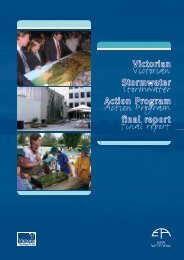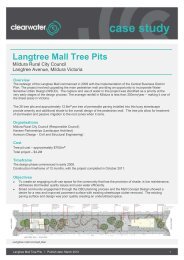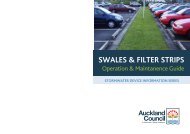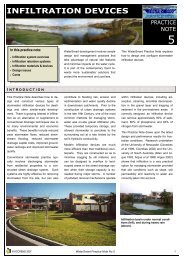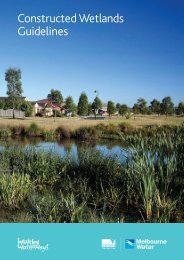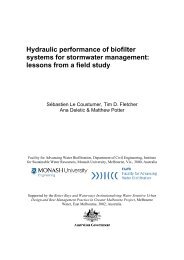CRC Street Sweep Eval 1999.pdf( 489.9 KB ) - Clearwater
CRC Street Sweep Eval 1999.pdf( 489.9 KB ) - Clearwater
CRC Street Sweep Eval 1999.pdf( 489.9 KB ) - Clearwater
Create successful ePaper yourself
Turn your PDF publications into a flip-book with our unique Google optimized e-Paper software.
COOPERATIVE RESEARCH CENTRE FOR CATCHMENT HYDROLOGY<br />
3 Methodology<br />
This study assesses the effectiveness of street<br />
sweeping for stormwater pollution control by:<br />
reviewing previous studies on sweeper<br />
performances and street pollutant characteristics,<br />
reviewing objectives for street sweeping<br />
operations (eg. aesthetic),<br />
considering rainfall distributions with street<br />
sweeping frequency and timing to investigate<br />
likely sweeper performance,<br />
examining field data from an earlier <strong>CRC</strong> study<br />
and others on gross pollutants,<br />
investigating the potential effects of changing<br />
street sweeping regimes on the gross pollutant<br />
loads in stormwater.<br />
This study interprets available Australian and<br />
overseas field data on the measured efficiencies of<br />
street sweeping and street surface sediments. Various<br />
studies describing the particle size distribution of<br />
sediment loads were also collated to provide an<br />
insight into the particle size distribution pattern of<br />
suspended solids typical of street surface runoff.<br />
Some significant overseas studies on the partitioning<br />
of sediment sizes and the contaminant associations<br />
(eg. metals and nutrients) with each particle size<br />
partition were used to assess the pollutants likely to<br />
be discharged into the stormwater system from street<br />
surfaces. Information regarding street sweeping<br />
efficiencies and sediment contaminant associations<br />
from these studies are combined with data on<br />
Australian stormwater suspended solids<br />
characteristics to enable an assessment of street<br />
sweeping practices on removal of fine particulate<br />
associated pollutants.<br />
A survey of street sweeping practices amongst<br />
municipalities in Melbourne was carried out to<br />
examine current sweeping objectives, procedures and<br />
mechanisms in these municipalities. This survey was<br />
also used to determine the perceived effectiveness of<br />
street sweeping in maintaining a certain standard of<br />
street aesthetics. Australian rainfall distributions<br />
were then examined and used to assess typical<br />
statistics of inter-event dry periods for Melbourne and<br />
other major capital cities in Australia. Melbourne<br />
inter-event periods were compared to the surveyed<br />
results of typical sweeping frequency and timing to<br />
investigate likely sweeper performance. This<br />
information facilitates a “hydrological basis” for<br />
selecting a street sweeping frequency that would<br />
optimise gross pollutant removal.<br />
The study also examines data obtained from field<br />
studies previously undertaken by the <strong>CRC</strong> for<br />
Catchment Hydrology and others to investigate the<br />
effectiveness of street sweeping on litter and gross<br />
pollutant removal. Gross pollutant load data gathered<br />
at 192 side entry pit traps (SEPTs - baskets fitted into<br />
roadside stormwater entry pits) in the suburb of<br />
Coburg in Melbourne by Allison et al. (1998) were<br />
grouped according to the street sweeping frequencies<br />
in their respective streets. Similar data are available<br />
at two further study catchments in the suburbs of<br />
Carnegie and McKinnon in Melbourne (Hall and<br />
Phillips, 1997). The load data captured by the SEPTs<br />
during a typical street sweeping program are used to<br />
evaluate the amount of gross pollutants typically<br />
entering the stormwater system under normal<br />
Melbourne street sweeping frequencies and<br />
conditions. While it was not possible to compute a<br />
measure of pollutant removal efficiency owing to an<br />
inability to account for pollutants by-passing the<br />
SEPTs, the data nevertheless provided an insight on<br />
what might be the expected gross pollutant export<br />
load from streets that are swept at regular intervals.<br />
5




